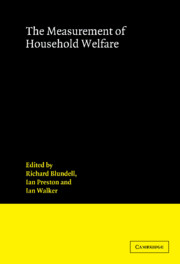Book contents
- Frontmatter
- Contents
- List of contributors
- 1 An introduction to applied welfare analysis
- 2 Measuring the cost of children: a theoretical framework
- 3 The collective approach to household behaviour
- 4 Ordinal and cardinal utility: an integration of the two dimensions of the welfare concept
- 5 The determination of welfare in nonintact families
- 6 Female labour supply, housework and family welfare
- 7 Engel equivalence scales in Sri Lanka: exactness, specification, measurement error
- 8 Measuring the life-cycle consumption costs of children
- 9 Family fortunes in the 1970s and 1980s
- 10 Ethically-consistent welfare prescriptions are reference price-independent
- 11 The effect of systematic misperception of income on the subjective poverty line
- Index of names
- Index of subjects
5 - The determination of welfare in nonintact families
Published online by Cambridge University Press: 13 January 2010
- Frontmatter
- Contents
- List of contributors
- 1 An introduction to applied welfare analysis
- 2 Measuring the cost of children: a theoretical framework
- 3 The collective approach to household behaviour
- 4 Ordinal and cardinal utility: an integration of the two dimensions of the welfare concept
- 5 The determination of welfare in nonintact families
- 6 Female labour supply, housework and family welfare
- 7 Engel equivalence scales in Sri Lanka: exactness, specification, measurement error
- 8 Measuring the life-cycle consumption costs of children
- 9 Family fortunes in the 1970s and 1980s
- 10 Ethically-consistent welfare prescriptions are reference price-independent
- 11 The effect of systematic misperception of income on the subjective poverty line
- Index of names
- Index of subjects
Summary
Introduction
Within both intact and nonintact families in which children are present, the allocation of resources to children is best viewed as the outcome of a complicated process in which love, altruism, investment motives, fairness, and self-interested behaviour on the part of parents all play a role. Except in extreme circumstances, such as child-neglect cases, official agents of the society like courts, social service agencies, and policing institutions interfere little in the intra-household resource allocation process.
In contrast, agents of societal institutions do intervene, at least indirectly, in the interhousehold consumption allocation decisions made by divorced parents. The principal instruments of intervention are the terms and enforcement of legally-stipulated divorce agreements as they relate to custody arrangements and wealth and income transfers between the ex-spouses. In our view, though parents and their legal representatives are able to shape the specifics of a divorce agreement, the environment wherein such agreements are concluded is sufficiently restrictive so as to necessitate our consideration of it as the main determinant of custody arrangements and child support orders (this approach was originally articulated by Mnookin and Kornhauser, 1979). Societal institutions only indirectly affect resource allocations in nonintact families because their interventions principally affect only the income distribution across households and, in the view taken below, the preferences of the parents. Presumably due to the existence of difficult monitoring problems and issues connected with rights to privacy, societal agents rarely prescribe interpersonal resource allocations directly to nonintact or intact families.
- Type
- Chapter
- Information
- The Measurement of Household Welfare , pp. 111 - 139Publisher: Cambridge University PressPrint publication year: 1994
- 1
- Cited by



